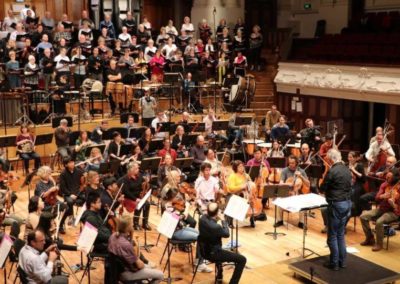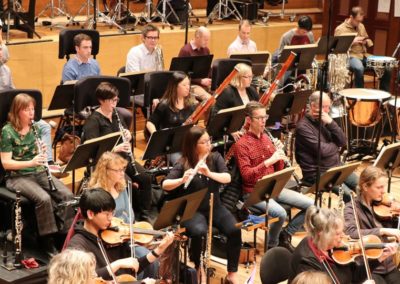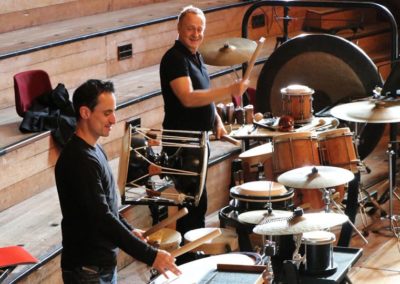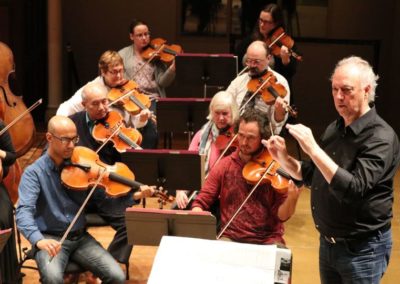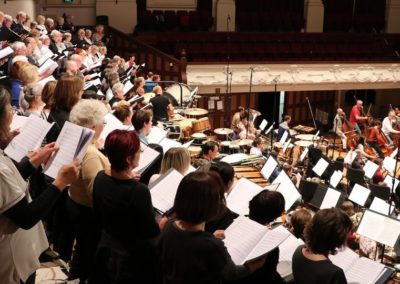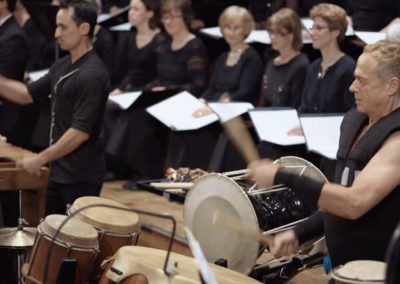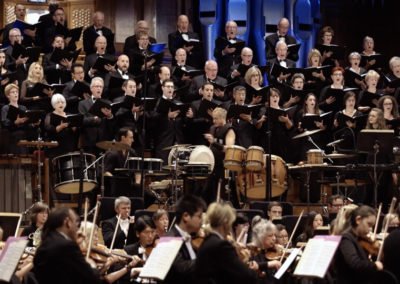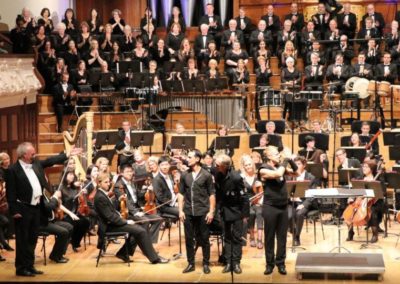TAKETINA SYMPHONIC
SYMPHONIC POLYRHYTHM
TAKETINA SYMPHONIC represents a new style of orchestral music in which complex polyrhythms, harmonic progressions and stunning percussion sounds merge in a dramatic and unique way. It is music that touches every level of human existence.
Waves upon Waves
by R. Flatischler & J. Bertl
Space beyond Space
by R. Flatischler & J. Bertl
Project
TAKETINA SYMPHONIC was founded by Reinhard Flatischler and Johnny Bertl, two Viennese composers from different backgrounds. Their highly specialized skills enable them to co-create music which neither could have created alone.
The underlying polyrhythmic structures in their compositions hearkens back to the musical wisdom inherent in the music of J.S.Bach. The overlapping polyrhythmic structures and primal rhythmic movements reflect the purity of nature. When polyrhythmic structures come together with melodic and harmonic progressions and unique percussion sounds, the Waves Project comes to life.
Compositions
WAVES UPON WAVES
Suite for Orchestra, Choir and Percussion in 6 movements
“Waves upon Waves” is an homage to rhythm, which is the primal power behind all forms of life. It also reflects the rhythms expressed in the powerful ocean waves surrounding New Zealand. It salutes the power and beauty of New Zealand’s nature.
The piece invites the audience to a shared experience of rhythmic excitement and inner stillness. With all its intensity it points to the empty space between the pulses, and the tangible but inaudible waves lying underneath the music, criss-crossing in complex polyrhythmic ways.
The composition is based on tempo ranges in which the human nervous system has a maximum response. This fact is backed up by newest science and it is no surprise that some of the tempos chosen for “Waves” are identical with the Credo in Bach’s “Mass in B minor”, Augurs of Spring in Strawinsky’s “Le Sacre du printemps” or the Molto allegro in Mozart’s “Symphony Nr. 40”. The intention of “Waves upon Waves” is, to immerse the listener into the rhythmic nature of all life, and establish rhythm as a mirror for a deeper insight.
"Waves upon Waves" takes the audience on a journey through six movements:
1 Awakening
starts with the still surface of the ocean, represented by one tone, sung a capella by the whole choir. From this stillpoint on, movement gradually starts to unfold in every growing wave and leads into a polyrhythmic matrix of seven and nine beat cycles.
2 Timelessness
begins as a journey through clusters and multiple meters. As they appear and dissolve again, it increasingly becomes apparent that they are connected through a hidden yet clearly tangible basic pulse.
3 Longing
is the beginning of „Waves upon Waves“ changing from transpersonal experience into tangible human emotion: the image of someone looking at the ocean, contemplating the separation of a beloved person on the other side of the waves, sets the mood for this movement.
4 Elysium
The scene changes into the image of an indigenous person sitting with a shamans drum on the shore. This person also looks out at the ocean, but is completely empty of thoughts and emotions and taken away by the rhythm of his drum – which in this case is played by the orchestra. As it gradually gains momentum it gets multi-layered and finally accumulates in a rhythm of unbelievable intensity: Indonesian Anklungs merge with the full orchestra, percussion and choir – everything is vibrating at its peak level while at the same time a deep space opens up for the listener – a space some call „the Zone“, others „Elysium“.
5 Power of Rhythm
is the virtuosic drum part in every Waves Production. Here, the big „Taiko“ Drum played by Reinhard Flatischler takes center stage. Flatischler’s drum style connects Korean Buk drumming with various Japanese Taiko styles. It is accompanied by the dynamic sound of a Balinese Cheng Cheng that gives the syncopating drum a solid background.
6 Matrix
the last movement featuring the polyrhythm of three and four, represented by the rhythm syllables „TaKeTiNa“ and „GaMaLa“, escalates into a grand interplay that involves every section of the orchestra, choir and percussion. In this grand finale the polyrhythm creates a joyfully confusing, yet musically coherent intensity merging into the final beat with an intricate break.
SPACE BEYOND SPACE
Suite for Orchestra, Choir and Percussion in 8 movements
„Space beyond Space“ had its world premiere on July 26th 2018 at Auckland Town Hall, New Zealand. It is the second composition commissioned by the Auckland Choral Society. Auckland Choral Society joined in the concert by Auckland Philharmonia Orchestra, conducted by Uwe Grodd. Reinhard Flatischler and Grammy nominee Tupac Mantilla performed on the solo drums along with a lineup of other percussionists.
Space is one of the most mysterious and fascinating phenomena existing. Space has stimulated the curiosity of humans from the very beginning. The most advanced scientists as well as ancient philosophers have been researching the phenomenon of space.
Newest science assumes that space is both – extremely full and unimaginably tense – while at the same time it appears completely empty. What a mystery!
“Space beyond Space” comes with a philosophical message. „Ubi nihil – ibi omnia.“ This statement carries such deep meaning, that it becomes a Latin Koan – something that cannot be grasped by the logic mind alone but eventually needs to include other layers of recognition to access a deeper understanding of space, the only phenomenon that connects everything with everything.
The eight movements from "Space beyond Space" are:
1 Prologue
Musically the prologue intends to create the atmosphere that something important is to be revealed. It gradually builds a rhythmic backdrop to present the first statement. “Ubi nihil, Ibi omnia” is recited first, for everyone to clearly understand the message: „where there is nothing there is everything“. This statement correlates with the ancient „heart sutra“, which starts like this: …“Form does not differ from emptiness; emptiness does not differ from form. Form itself is emptiness; emptiness itself is form.“ It also points to the finding of modern science. The prologue directly leads to the second movement.
2 Ubi Nihil
To access the deeper meaning of this condensed information, the second movement leads the audience through a polytonal „birthing process“ with a massive intensity of sound and rhythm input, that is intended to crack open the mind for venturing out to new horizons.
3 Revolving Galaxies
The Big Bang sends out its different movements through the musical universe. Inner galaxies, rhythmic galaxies and sound galaxies – all blend together at this point. Various polyrhythmic layers and complex cycles interact sometimes in a very dynamic manner, sometimes in contrast withdrawing into a more static mood. „Revolving galaxies“ ends in a culmination that calls the drums to take centerstage.
4 Power of Rhythm
Every composition of the „Space Project“ has movements in which the art of playing drums in a virtuosic manner is integrated into the composition. Here, Tupac Mantilla und Reinhard Flatischler are interacting with the whole orchestra that turns now into a mighty rhythm generator as well.
5 Beyond Space
Everything so far was a preparation to dive into the actual meditation of this mysterious phenomenon space. It starts with a portal in which quite unusual sounds call the listener into a direct participation of contemplating space. Beyond space consists of a metamorphosis of three rhythms: starting with a twelve beat cycle, the rhythms evolve into an eleven beat cycle, recited by the choir in multiple voice layers and ending up in a mysterious layering of a seven and a six beat cycle. When their elements are „singled out“ – which is a composition technique of the Waves Project – the audience feels a coherence but cannot grasp how everything is interconnected. An atmosphere of wondering, awe and introspection opens up.
6 Spatium Omnia Tu
Never before has there been a coherent polyrhythmic choir in the history of classical and avant-garde music. The polyrhythm of three and four create an unstoppable drive, which is different from groove, just based on one pulsation alone. This movement conveys the following messages, sung by the choir:
„Spatium, omnia tu, Omnia nosti, Omnia saecula!
Spatium, omnia tu, Omnia iungis, Omnia omnibus!
Tu narra de terra, Narra de nobis Narra caelestibus!“
„Tu es via clara, Tu es noster angelus,
Testare hanc vitam, Narra mundo nostram musicam!
Tu es via clara nostra, Tu es noster vere unus angelus!
Testare hanc vitam, Nostram musicam!“
translates into:
„Space, you know everything, really everything, all ages
Space, you connect everything, everything with everything
You, tell us about the earth, tell us about us, tell us about the heavenly beings.“
„You are the shining path, you are our messenger
bear witness to this life on earth, recount our music to the universe
you are our shining path, you are our one true messenger indeed
bear witness to this life and to our music.“
7 Contemplation
The title already suggests that this is a moment of contemplation and resting point before the final movement. Completely new sound combinations of ancient temple bells with low frequency and high frequency clusters played by the orchestra provoke deep listening and introspection before finally returning to the initial statement: „Ubi Nihil – Ibi Omnia“
8 Ubi Nihil Return
It is impossible to escape space and therefore it is a consequent move that „Space beyond Space“ returns to Ubi Nihil in the end. However, no one ever returns to the same place or situation in such a journey. This times all the elements from the beginning have changed into a hymn of uplifting joy, vigor and courage. The last words sung by the choir in a very still a capella mode remind that even in the most dramatic situation there is always emptiness and space.
Composers
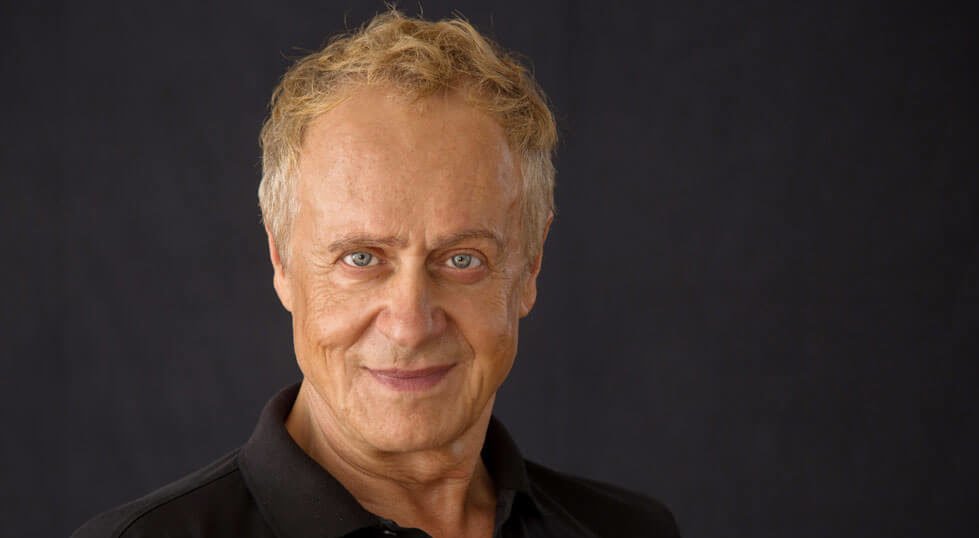
REINHARD FLATISCHLER
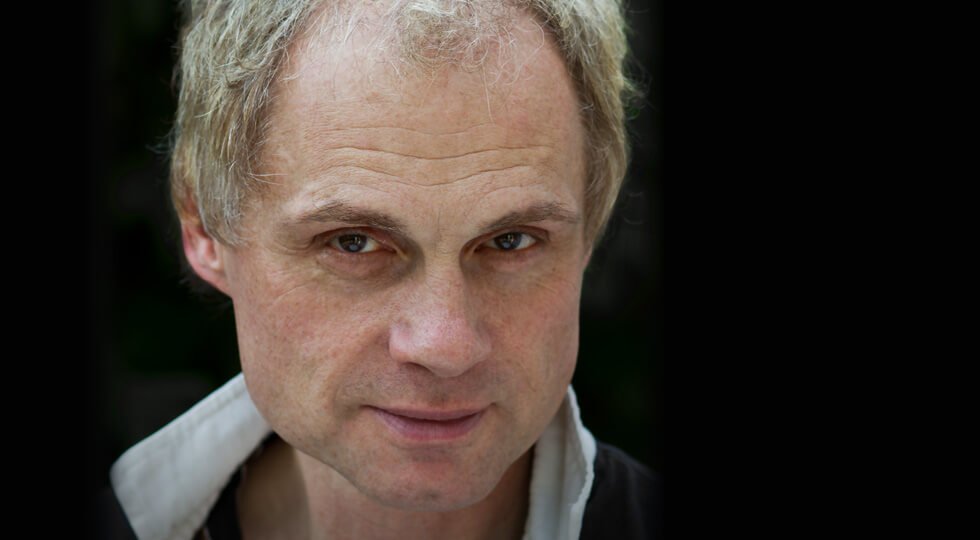
JOHNNY BERTL
Johnny Bertl is a specialist in orchestral music. His career spans almost 40 years of highly successful projects in which classical orchestras meet world music, jazz, pop, or folk. Bertl has arranged, composed or conducted for Joe Zawinul, Bobby McFerrin, Chaka Chan, Alan Parsons, Placido Domingo, Elina Garanca, Piotr Bezcala , Andreas Gabalier to name just a few. He directed several opening nights of the prestigious ‘Wiener Festwochen’ (Vienna Festival ), arranged the orchestra for the notorious Viennese ‘Life Ball’ and composed the musical “Falco meets Amadeus”.
Musicians
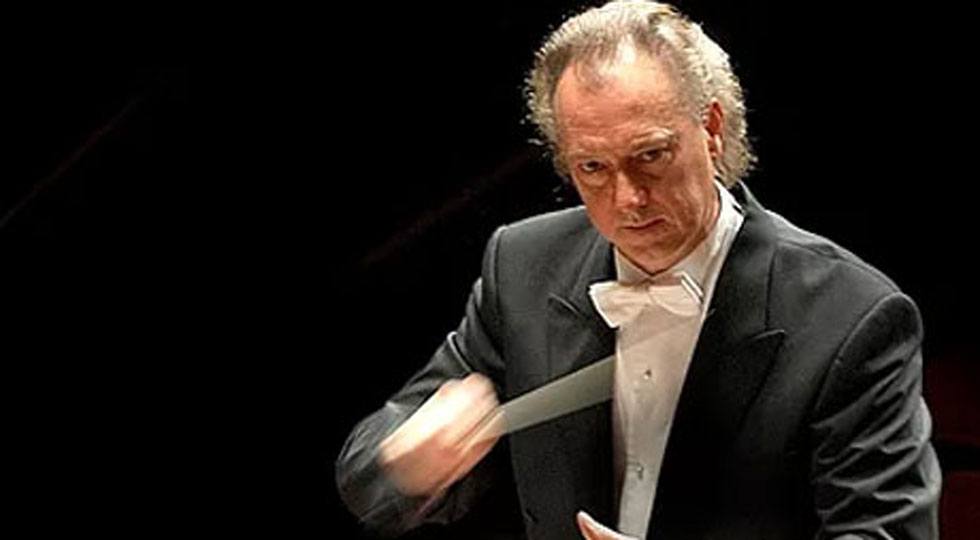
UWE GRODD
A graduate of Mainz University, Germany, Uwe studied with teachers of international repute. A strong musical influence during his study was choral specialist Helmut Rilling during several summer courses at the Bach Akademie in Uwe’s hometown of Stuttgart. He attributes his major musical growth to the guidance of two of Europe’s finest musicians, Robert Aitken and Maestro Celibidache.
In 1993 Uwe was appointed Music Director of the Manukau Symphony Orchestra, and between 1998 and 2002 acted as Artistic Director of the International Music Festival New Zealand. He was invited to become Music Director of the Auckland Choral Society, New Zealand’s longest-established symphonic choir, in July 2008.
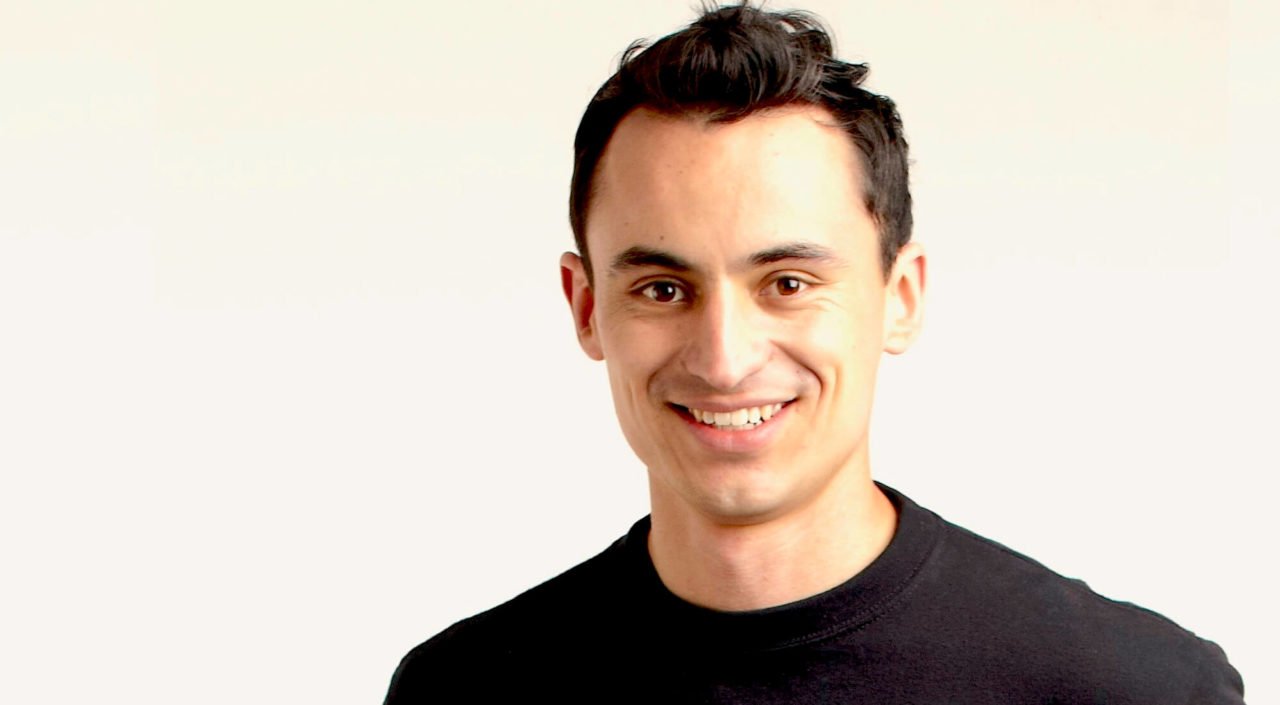
TUPAC MANTILLA
Grammy® nominated percussionist Tupac Mantilla is considered nowadays one of the leading forces in the contemporary rhythm world, supported by a prolific career that includes appearances as a performer in concert halls such Carnegie Hall and as a lecturer and educator in institutions like Harvard and Stanford University. He has collaborated with artists such as Bobby McFerrin, Esperanza Spalding, Savion Glover and Zakir Hussain to name a few.
As the artistic director and founder of Colombia’s Body Percussion troupe TEKEYÉ and the Global Percussion Network PERCUACTION, his innovative methods, books and systems have benefited directly more than 100.000 people around the world. In recent years Tupac’s energetic and interactive workshops and shows have become a highly in-demand activity of top institutions, festivals and venues.
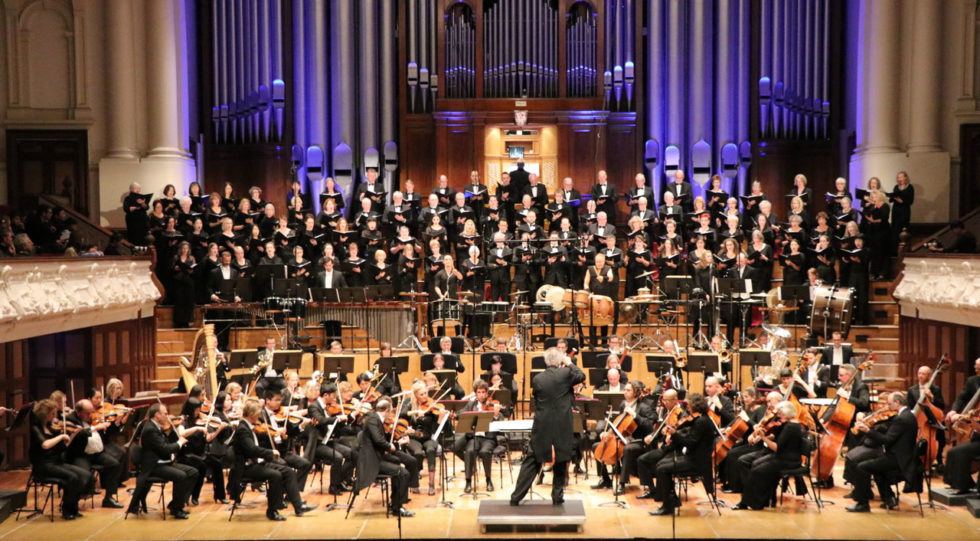
AUCKLAND CHORAL SOCIETY AND AUCKLAND PHILHARMONIA ORCHESTRA
Auckland Choral is a symphonic-scale choir of 100+ voices. It is Auckland’s oldest and most prominent choir, and continues to play a significant role in Auckland’s art scene today.
Its members are wide-ranging in age as well as cultural and professional background. Members rehearse weekly throughout the year and the choir regularly accepts new members following a thorough audition process. The current music director is Professor Uwe Grodd.





